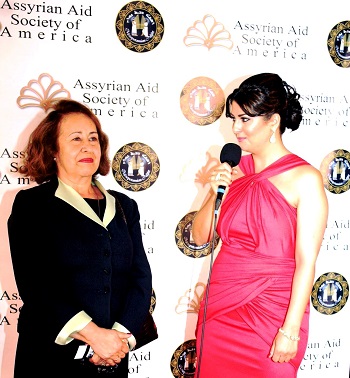 Modern Aramaic makes a comeback as a language of entertainment By Eden Naby In 2007 when at the FEL annual conference (Kuala Lumpur) the participants adopted a resolution recognizing Aramaic as the oldest continuously written and spoken language of the Middle East, Assyrians, the main speakers of modern Aramaic, were already on the run for their lives in Iraq.
Modern Aramaic makes a comeback as a language of entertainment By Eden Naby In 2007 when at the FEL annual conference (Kuala Lumpur) the participants adopted a resolution recognizing Aramaic as the oldest continuously written and spoken language of the Middle East, Assyrians, the main speakers of modern Aramaic, were already on the run for their lives in Iraq.
Now the same thing is happening in Syria.
But in that same year, a seed began to germinate in northern California, that is reintroducing Aramaic as a language of entertainment. The effort, spearheaded by Tony Khoshaba, Ph.D. computer engineer, began as a means to raise funds to help displaced Assyrian refugees in Iraq not through picnics and sponsored sports, or a begging bowl that tugs at the heart strings of Assyrians in the American diaspora. No, the focus was on entertainment together with fund raising. Apparently, there was a pent up desire to develop music, theater, choral music and other forms of stage performance. Mesopotamian Night, as the annual event has been called, just completed its eighth year.
The first performance took place in a walnut orchard in Modesto, CA (boyhood town of George Lucas). It consisted of a quartet playing western instruments as accompaniment to arias sung by American singers – but in the modern Aramaic dialect of the eastern Assyrians who, before the WWI period genocide, used to stretch from southeast Turkey to the western shores of Lake Urmiah and south through what was ancient Mesopotamia in present-day Iraq.
Mesopotamian Night has grown in popularity, expanded to ever larger theater settings, and has become an annual fixture at the San Jose Opera. In 2014, for the first time, part of its repertoire, with added local music and dance, went to Chicago. In May 2015, again using some of the same repertoire as San Jose, but with added poetic recitation and newly commissioned music, it was presented in Los Angeles.
A single evening’s performance, captured on DVD and CD, thus far, Mesopotamian Night has raised about half a million dollars for refugee causes, with expenditures of about the same amount in artistic commissions and production costs. Its contribution to the revival and expansion of Assyrian entertainment goes well beyond money: it has revived an interest in the music and song of the 20th century as developed among Assyrians in Iraq, Iran and Syria, encouraged wider knowledge of Assyrian poets and poetry, both living and deceased, and it has promoted musical composition that while drawing on Assyrian folk music, allows for greater polyphonic diversity.
How to Entertain a Scattered Ethnicity
Music, poetry and story-telling have constituted the mainstay of entertainment for lesser developed societies throughout the 19th century. Assyrians living in northwest Iran, largely through exposure to Western culture acquired with the active educational presence of American, French, German and Russian missionaries, expanded their appetite for entertainment prior to the genocide of World War I. Newspapers, translated novels and poetry, original novels and plays performed and printed, began to circulate in the increasingly sophisticated and western educated corner of an emerging Iran. Not until after WWII however, did the survivors of the genocide in eastern Turkey and northwest Iran, reduced by the twothirds lost to death and emigration, begin to recover sufficiently to embark on cultural activities. Between the two wars, Assyrians had been reduced to the basic entertainment of singers and drum and woodwinds provided for circle dancing at picnics, weddings and church celebrations. Still some men and women continued to produce written materials, some not published until the turn of the 21st century in American diaspora.
For its primary content, the renewed Aramaic language entertainment germinating in California draws on the written plays, skits, songs and poems produced by such men and women. These creative individuals owe their sensibilities and opportunities to that progressive social, educational and cultural atmosphere made possible by missionaries initially, then by opportunities for international study, as in the cases of Hannibal Alkhas (1930- 2010), and William Daniel (1903-1988).
Following the Islamic Revolution in Iran in 1979 when all Iranians, but especially non-Muslim ones, saw their loyalty to Iranian nationalism betrayed by the Khomeini constitution of 1981, wave upon wave of Assyrian emigration ensued, mostly to the United States and Australia.
The three decades of Baathist Iraq saw a similar depletion of Iraq’s Assyrian population, the largest in the Middle East, which had been augmented by flight to British held Iraq during the genocide from both Ottoman Turkey and Iran. The fall of the Iraqi dictatorship and the anti-Christian attitude that emerged in 2004 with extremist Muslim ascendancy meant a drop in the Assyrian population of Iraq to 1/3rd its population of 1.5 million. The subsequent flight to the United States and Australia from the Middle East has helped to create a relatively compact and educated Assyrian presence in towns like San Jose, San Diego, Los Angeles, Phoenix in the United States, and in Sydney, Australia. These communities added to the core American Assyrian centers like Detroit, Chicago, and Turlock.
Filtered through families and churches, from that original push by 19th century missionaries to create culture in Aramaic outside the confines of classical ecclesiastical Syriac, a number of men, and some women, emerged who led a cultural revival, as volunteers with paid employment outside the cultural sphere. These same dedicated volunteers received their professional skills through the largely merit based educational system in Pahlavi era Iran (1923-1979) which created the extensive middle class of Iranian society across ethnic and religious divides.
In San Jose, engineers and some doctors, began to envision the concept that has created Mesopotamian Night: an event that takes its content from existing, if obscured, Assyrian poetry, commissions music, and draws upon church choir members to create an evening of a level of entertainment in Aramaic probably not experienced by any Assyrians since the days of empire 3000 years ago.
Unlike other cultures, there is no state for the Assyrians to funnel money into culture. When cultural advances have sprouted, they have done so despite state censorship and discouragement. It is a brave cultural effort perhaps as unique as Aramaic itself.
The success of the use of Aramaic for entertainment depends on management, artistic and performance talent, and funding. The question before Mesopotamian Night organizers is whether community support would be forthcoming were proceeds from the events not dedicated to Assyrian refugees in the Middle East, schools, medical clinics, small commercial enterprises and so forth.
The Talent
Most of the talent on stage, especially for the singing, comes from church choirs across the spectrum of denominations represented in San Jose by seven churches. For centuries, the preservation of language and culture had relied on churches. Trained voices chanting the complex modes of music at services usually consisted of men. Indeed, women have not been allowed at the altar in the Syriac Orthodox Church & others thus leaving all functions of the service to the clergy and deacons. But gradually the adoption of women’s chorus has led to gender equality in the training of voices, knowledge of melodies and the classical Syriac content of chants. Many professional singers in the Assyrian (including Chaldean and Syriac) communities began their singing performances as five or six year old children in church choirs.
On the other hand, modern musical composition has largely developed from the talent of western-oriented persons familiar with orchestral instruments. Thus piano/organ, violin, and guitar added to an instrument array that had consisted of a horn (Zurna), drums (davula) as well as the more sophisticated oud, a stringed instrument that some Assyrian men continued to craft, even in diaspora.
The successful entertainment that is represented by Mesopotamian Night relies heavily on an orchestra, some of whose members are themselves Assyrian, though the preponderance is local American. The melodies and orchestration has increasingly become commissioned from Assyrians: Edwin Elieh, a transplanted Urmiah resident living and working in Los Angeles has proven particularly adept at both composition and orchestration. A fine example of his work is the music for the 2012 musical production: Malek Rama Lakhouma (http://smile.amazon.com/Malek-Rama-HandsomeMesopotamianNight/dp/B00B6A44SW/ref=sr_1_cc_5?s=aps&ie=UTF8&), based on a poem by Hannibal Alkhas, set to a fairly complex twohour musical performance.
Performance Reception
Of the multiple cultural goals of the volunteers who work for months to produce the one night only performance, the primary one is entertainment through the promotion of Assyrian language performance based on Assyrian stories, poems, dances, and traditions. But a one-night stand can have limited long-term influence. Even the CDs and DVDs do not circulate widely though they are promoted through social media as well as Amazon and the Mesopotamian Night’s own website.
The long-term success of this tremendous dedication and effort is in producing a set of musical scores, arrangements and poetic composition that becomes a cultural storehouse for future generations. Despite the loss of the works of many lyrical poets during the genocide, a repertoire is accumulating that can be tapped, as long as the written and spoken word can be preserved. Thus the body of material can be useful beyond the one night stand in Silicon Valley.
As immediate proof we see the transportation of dramatic and musical pieces such as “Talibutha,” (The Engagement) a comic poem by William Daniel that was staged both at the Chicago and Los Angeles Mesopotamian Night events. The genocide themed poem, “The Tale of Badri,” composed by Jean Alkhas (1908-1969), and set to music by Shmuel Khangeldy, will likely see repeat performance in Chicago and elsewhere.
The more serious performance reception question is whether Aramaic language performance for an Assyrian diaspora community can actually attract those beyond the first generation of immigrants. Will the strength of the performances bring in audiences whose grasp of Aramaic is diluted by schooling in an English-speaking milieu? Or wlll the music and attractiveness of performance draw even those who do not speak Assyrian well?
We have to go back to the churches for an answer: As long as the churches continue to promote Assyrian and train young deacons and girls who sing in the choirs, the talent and the audience may be hooked on entertaining performance.
But thinking ahead, both founders and volunteers are seeking to expand the range of audience and performance by moving beyond the Assyrian community. In part, this can be done through translation from other Middle Eastern languages, as for example, “The Little Lantern,” an Arabic poem, translated into Aramaic, set to music by George Somi, and performed as the main feature of the 2014 Mesopotamian Night program. In future programming, music from the Nash Dedan ( a Jewish Aramaic speaking community almost swallowed within Hebrew speaking Israelis) may be included. The Nash Dedan and the Assyrians are the only remaining communities that have Aramaic as a native language.
The preservation of Aramaic as a spoken language goes beyond those with a heritage claim: Maronites and some other native Christian groups in Israel appear to be searching for ways to assert their separateness from the Arabs, most of whose culture is permeated by Islam and increasingly by radical animosity toward native Christians as well as other Christians. How far this adoption of Aramaic will proceed remains to be seen. But for the time being, it is through Assyrian entertainment that the force of Aramaic is surviving in American diaspora.
